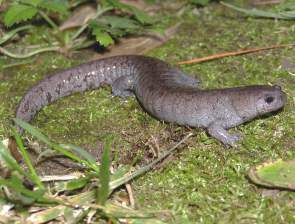Streamside salamander facts for kids
Quick facts for kids Streamside salamander |
|
|---|---|
 |
|
| Conservation status | |
| Scientific classification |
The streamside salamander (Ambystoma barbouri) is a type of mole salamander that lives in the central United States. These cool amphibians are found in several Midwestern states.
Where Streamside Salamanders Live
Adult streamside salamanders like to live underground. You can also find them hiding under rocks or leaves in forests. These forests usually have trees that lose their leaves in the fall.
When it's time to lay eggs, streamside salamanders usually choose small streams. Sometimes, they might lay eggs in ponds. Young salamanders, called larvae, often hide among green algae. This helps them stay safe from animals that might try to eat them.
Scientists have studied streamside salamanders to understand how gene flow affects how well animals adapt to their homes. Imagine some salamander babies live in a pond with fish that want to eat them. These babies survive better if they are quiet and hide a lot.
Now, imagine other salamander babies live in a small pool that dries up quickly. These babies survive better if they are active and eat a lot. This helps them grow fast enough to change into adult salamanders before their pool disappears.
Here's the tricky part: sometimes, salamanders from the "hiding" group and salamanders from the "active" group have babies together. This mixing of genes is called gene flow. Because of this mixing, neither group of salamanders can fully adapt to their specific environment. This means the salamanders might not be as strong or healthy as they could be if they were perfectly suited to just one type of home.
Protecting Streamside Salamanders
Scientists think there are more than 10,000 streamside salamanders in total. However, it's hard to get an exact count.
These salamanders are facing challenges. Their homes are being destroyed when forests are turned into farms or places for people to live. This habitat destruction puts pressure on the salamander population. Protecting their forest and stream homes is important for their future.


